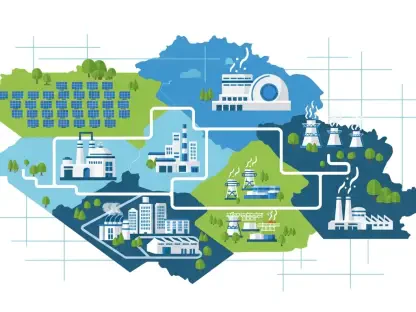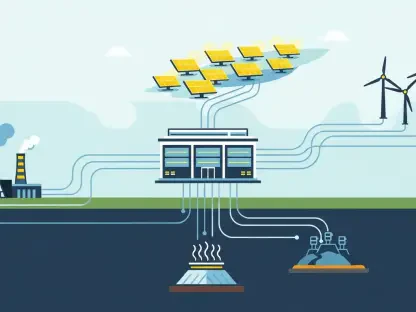BP’s recent decision to offload its onshore wind energy business in the USA marks a significant shift in its strategic focus. Under the leadership of new CEO Murray Auchincloss, BP is pivoting back to oil and gas, revealing broader challenges and trends within the renewable energy sector.
BP’s Asset Sale: A Strategic Pivot
Divesting Wind Power Projects
BP has opted to sell ten wind power projects located across seven states, collectively contributing 1.3 gigawatts of net generating capacity. This move is part of a more extensive strategy to integrate the development of onshore renewable energy projects within its subsidiary, Lightsource bp. By acquiring full control of Lightsource bp, a premier solar power specialist, BP is signaling its intent to deepen its commitment to solar energy. The decision comes as BP navigates the shifting landscapes of investor expectations and economic realities that demand a recalibration of its energy portfolio. Taking control of Lightsource bp indicates BP’s readiness to concentrate its resources and efforts on what it perceives to be more strategic, promising, and potentially profitable renewable energy avenues.
This strategic pivot is not an isolated event but rather a reflection of the company’s broader recalibration under Auchincloss’s leadership. Former CEO Bernard Looney had ambitious plans aimed at a swift transition toward sustainable energy, with a strong emphasis on wind power. However, the complexities of achieving economic viability in the current market climate have necessitated a shift in focus. Lightsource bp’s role is now set to become even more vital, as it provides BP with a capable and specialized platform for advancing its renewable energy projects, particularly solar. By reallocating resources to Lightsource bp, BP aims to secure a more efficient and streamlined approach to its renewable energy ventures, likely enhancing both project execution and financial returns.
Aligning with Investor Expectations
Investor pressure has been a significant catalyst for BP’s strategic shift. The renewable energy sector has faced declining profitability, pushing BP to refocus on more lucrative ventures. Under former CEO Bernard Looney, BP aimed for an ambitious transition towards sustainable energy, but current market realities have necessitated a recalibration under Auchincloss. This shift towards oil and gas ensures that investor concerns about profitability are addressed. The evolving investor landscape has seen increasing demands for not only sustainable practices but also financial returns that align with market expectations. Murray Auchincloss has had to navigate these dual pressures skillfully, ensuring that BP remains attractive to its investor base.
The recalibration also aligns BP with broader market data suggesting the economic challenges faced by renewable energy projects. For instance, the profitability of wind energy, once seen as a key growth area, has suffered due to rising costs and logistical challenges. Investors, therefore, have become more cautious, prompting BP to reassess its portfolio for maximum return on investment. This strategic shift is emblematic of how energy companies must balance sustainable goals with economic imperatives. BP’s renewed focus on oil and gas, while still maintaining a foothold in the renewable sector through Lightsource bp, can be seen as a pragmatic approach to securing a stable financial future while not entirely abandoning its sustainability commitments.
Economic Viability and Market Trends
Challenges in the Renewable Energy Sector
The renewable energy market in the U.S. is encountering substantial challenges. Rising material costs, high interest rates, and supply chain disruptions are forcing companies to renegotiate or cancel power purchase agreements for wind projects. Major players like Ørsted are also grappling with these issues, complicating the financial outlook for both wind and solar energy ventures. The financial hurdles facing renewable energy projects are underscored by a series of systemic issues. The continuous rise in the cost of materials has been a significant deterrent to new investments, while supply chain disruptions have led to substantial project delays. Collectively, these factors have eroded the economic viability of numerous ongoing and planned projects.
High interest rates further exacerbate these problems by inflating the cost of financing new ventures, making it increasingly difficult to justify large-scale investments in the sector. As a result, many companies have had to renegotiate or even cancel agreements, contributing to a climate of uncertainty. The cascading effects of these issues are felt across the sector, from smaller developers to major industry players. This economic backdrop has forced companies like BP to reassess their strategic priorities, focusing on areas where they can more reliably secure returns on investment. The decentralization of efforts and resources into more stable and predictable sectors, like oil and gas under Auchincloss’s leadership, can thus be seen as a measured response to these broader market challenges.
Impacts on Energy Projects
Inflation and supply chain snafus are delaying project timelines and escalating costs, making it harder to achieve economic viability. High interest rates further exacerbate the situation, increasing the cost of financing new projects. These market conditions have made it increasingly challenging for companies like BP to justify substantial investments in onshore wind energy. Faced with these economic variables, BP’s decision to divest from onshore wind and focus resources on its subsidiary, Lightsource bp, could be seen as an adaptive, risk-mitigating strategy. It allows the company to navigate the treacherous terrain of fluctuating market dynamics with a more specialized focus.
The strategic realignment will likely offer better opportunities for BP to manage project costs and timelines more efficiently. Lightsource bp’s established expertise in solar development can provide a more reliable pathway to achieving both financial and sustainability goals. Additionally, concentrating efforts in sectors less affected by supply chain volatility and higher interest rates could prove to be a stabilizing factor for BP’s overall portfolio. The broader market trend, characterized by renegotiations and cancellations, underscores the volatility and challenges within the renewable energy sector. Yet, BP’s strategic pivot demonstrates an effort to remain adaptive and responsive, ensuring its long-term sustainability and profitability.
Lightsource bp’s Enhanced Role
Leveraging Solar Expertise
BP’s decision to concentrate its renewable energy initiatives through Lightsource bp is both strategic and practical. As Europe’s largest solar developer, Lightsource bp offers a solid platform for expanding solar projects. This move allows BP to reduce its exposure to the riskier and currently less profitable onshore wind sector. Lightsource bp’s established expertise and infrastructure in solar development present BP with a more stable and promising avenue for fulfilling its renewable energy commitments. By channeling its renewable efforts through a specialized subsidiary, BP can leverage Lightsource bp’s proficiency, potentially achieving more efficient project execution and higher financial returns.
The strategic realignment aims to capitalize on Lightsource bp’s market position and technical know-how, creating a more cohesive and focused approach to renewable energy development. While wind energy has faced multiple logistical and financial hurdles, solar presents a comparatively less volatile investment landscape. Lightsource bp’s track record and industry standing offer BP the opportunity to mitigate risks and streamline operations. This strategic shift illustrates BP’s intention to consolidate its renewable energy efforts within a framework that promises greater predictability and profitability, reducing overall exposure to market volatility and enhancing governance over project timelines and execution.
Synergies and Profitability
Integrating solar and wind projects under Lightsource bp’s specialized management can streamline operations and maximize synergies. This setup potentially offers better returns on investment while continuing to fulfill BP’s commitment to renewable energy. Investors are likely to appreciate this focus on a more dependable and profitable segment of the renewable market. A well-integrated approach facilitates streamlined project management, maintenance, and operational efficiencies. This synergy can significantly enhance the cost-effectiveness and profitability of BP’s renewable energy ventures. The consolidated management promises more consistent performance and financial outcomes, addressing investor concerns effectively.
Creating such integrated operations within Lightsource bp means that BP can strategically deploy its resources in ways that maximize returns while fulfilling its renewable energy commitments. This balanced approach not only reassures investors but also positions BP strongly in a competitive renewable energy market. The practical benefits of this integration include reduced overheads and improved operational efficiency, translating to a more favorable financial outlook. This strategy serves to bolster BP’s market position and fortify its renewable energy portfolio amidst challenging economic conditions.
Navigating Investor Expectations and Sustainable Practices
Balancing Profitability and Sustainability
BP’s renewed focus on oil and gas does not absolve it from the responsibility of sustainable practices. By efficiently managing Lightsource bp’s solar assets, BP aims to balance immediate financial returns with its long-term sustainability goals. This dual approach will be crucial in navigating shifting investor expectations. As the global focus on sustainability intensifies, BP must demonstrate its ability to operationalize green initiatives effectively while ensuring shareholder value. The nuanced balance between these twin objectives—profitability and sustainability—will be pivotal to BP’s strategy moving forward.
Effective management of Lightsource bp’s solar projects will be a litmus test for BP’s commitment to renewable energy. By focusing on solar, BP can progress toward its sustainability goals without compromising short-term financial performance. This strategic alignment ensures that BP remains an attractive proposition for investors who are increasingly sensitive to environmental, social, and governance (ESG) criteria. Meeting these dual criteria will be pivotal in maintaining investor confidence and market credibility.
Strategic Realignment
BP’s exit from onshore wind power can be viewed as an adaptive response to the current economic environment. Focusing on more profitable ventures allows BP to stabilize its financial standing while still pushing forward with renewable energy projects through Lightsource bp. This strategic realignment positions BP to better handle the complex dynamics of the energy market. An economically prudent approach to renewable energy projects, combined with a sustained focus on oil and gas, allows BP to navigate market challenges more adeptly. The strategic reallocation reflects BP’s commitment to adapt and evolve within a rapidly changing energy landscape.
Drawing insights from current market trends, BP’s approach signifies a nuanced and multi-dimensional strategy. The company’s dual focus aims to maximize immediate returns while laying the groundwork for long-term sustainability. This balanced strategy should enable BP to navigate the intricacies of fluctuating market conditions and investor expectations. The strategic emphasis on Lightsource bp as the focal point for renewable projects embodies BP’s adaptive and forward-thinking approach in a demanding economic context.
Future Outlook for BP
Continuous Evaluation of Strategic Priorities
Moving forward, BP will need to continuously evaluate and adjust its strategic priorities. The company will have to juggle the necessity of short-term profitability with the growing demand for sustainable practices. Effective management and development of profitable solar projects through Lightsource bp will be key to achieving this balance. As BP navigates the evolving landscape, maintaining flexibility and adaptability will be crucial. The dynamic energy market necessitates a strategic approach that is both responsive to current demands and anticipatory of future trends. BP’s ability to pivot and recalibrate its strategy in alignment with market conditions and investor expectations will define its future trajectory.
In addition to maintaining a responsive strategy, BP will need to focus on innovation and efficiency to enhance project delivery and cost management. Emphasizing technological advancement and operational efficiencies will be critical to sustaining its competitive edge and fulfilling both profitability and sustainability targets. This ongoing evaluation and innovation will allow BP to maneuver effectively within the complex and evolving energy sector.
Addressing Market Conditions
BP’s latest move to sell off its onshore wind energy operations in the USA marks a notable shift in its strategic direction. Under the helm of new CEO Murray Auchincloss, BP has decided to return its focus to oil and gas. This pivot highlights broader challenges facing the renewable energy sector.
Since taking over, Auchincloss has steered BP towards a path that’s more aligned with traditional fossil fuels, indicating potential difficulties in navigating the renewable energy landscape. While BP had initially committed to expanding its renewable energy portfolio, the recent decision suggests a reassessment of priorities. It appears the company is opting for the reliability and profitability that oil and gas are known for, rather than pushing forward in the more unpredictable and competitive renewable energy market.
This decision sheds light on the difficulties major energy companies face as they balance the demand for green energy with the financial robustness associated with fossil fuels. Despite global pushes for sustainable energy solutions, fossil fuels continue to dominate because of their mature markets and established infrastructure.
By realigning its focus, BP might be aiming to solidify its financial base with traditional energy sources before making any future renewable investments. This strategic redirection also reflects broader industry trends where companies favor stability over the uncertainties in the renewable sector.









